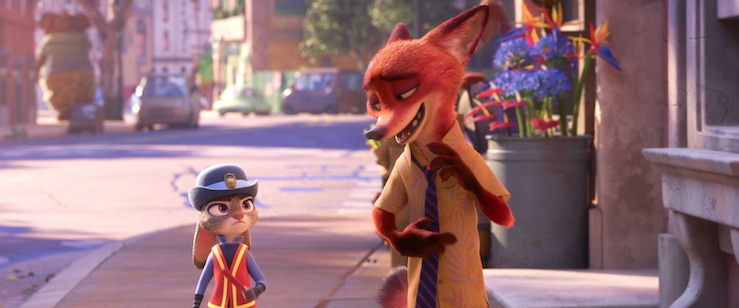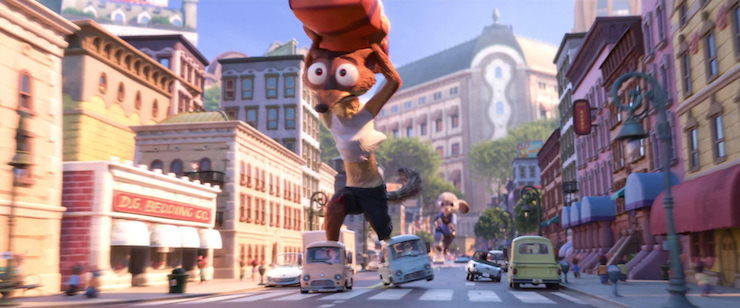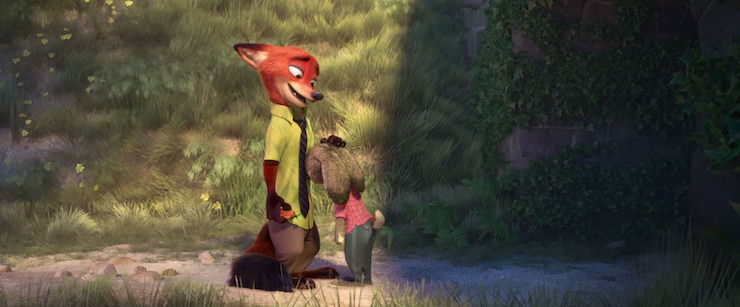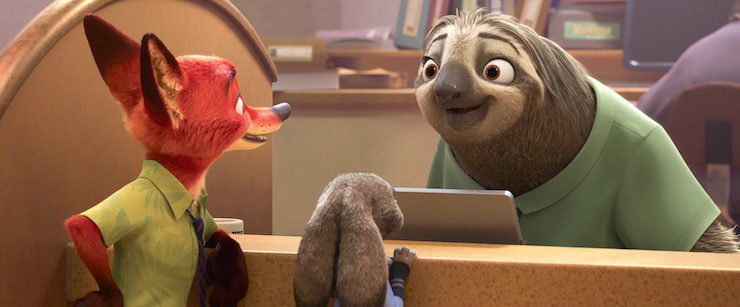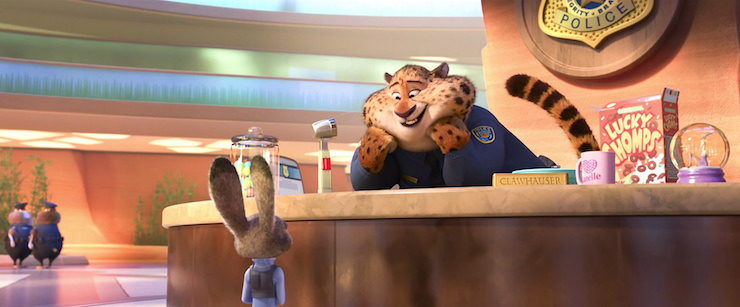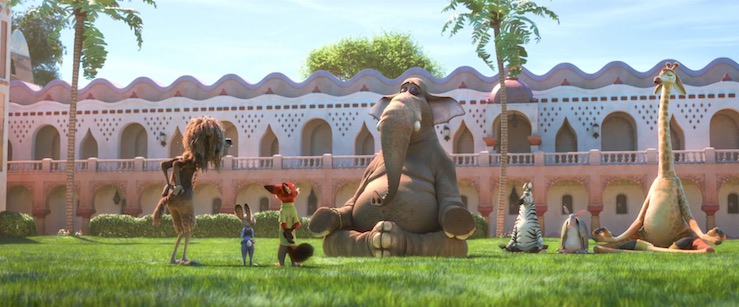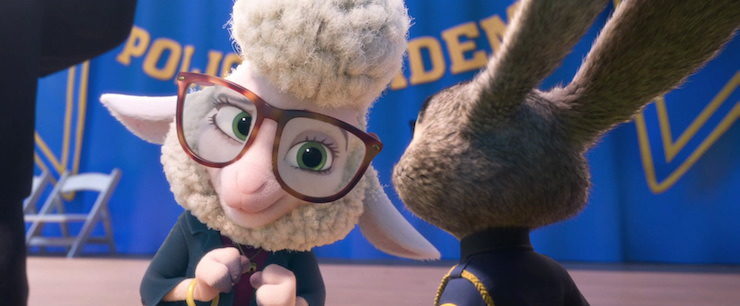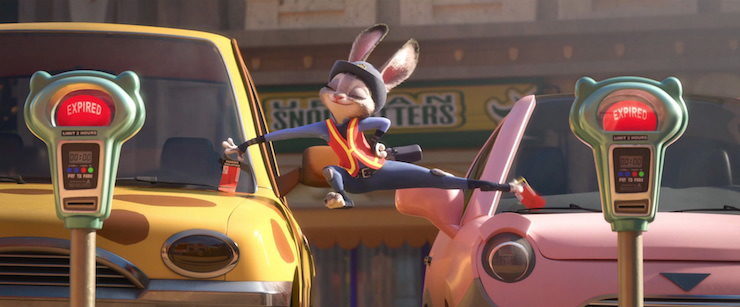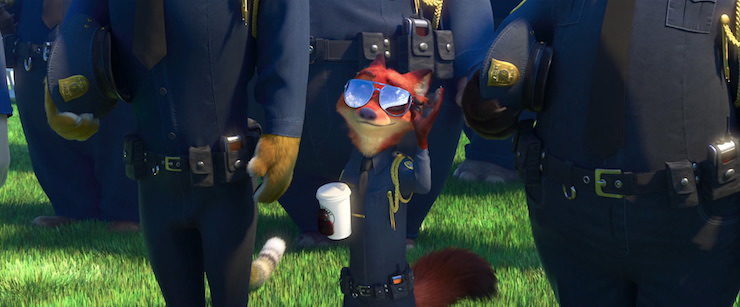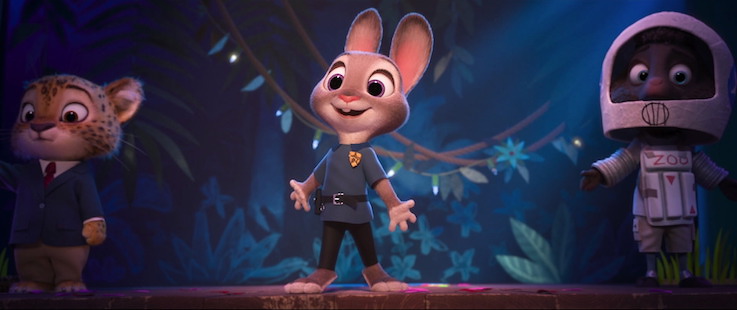Disney had, essentially, built its company on cute cartoon animals. So it was hardly surprising that after John Lasseter took over the Disney animation studios in 2006, he encouraged the animators and others to continue to pitch stories about cute, funny, cartoon animals that could easily be converted into toys. What was surprising was that despite this history, corporate encouragement, and a strong box office performance from the dog-centered Bolt (2008) it took animators nearly ten years to develop another film featuring only animals, Zootopia.
Almost instantly, it became one of Disney’s all time most successful films.
MAJOR SPOILERS AHEAD.
The idea behind Zootopia—that is, the concept of a world without humans, where predators and prey have learned to interact and create a city featuring sections built to accommodate different ecosystems—was the brainchild of director Brian Howard, who had started his career as a Disney animator before working as a co-director on Bolt and Tangled. Howard had a distinct fondness for cartoon animals, and was particularly inspired by the anthropomorphic Robin Hood. Chief Creative Officer John Lasseter approved his pitch, and animators started working on concept art shortly after finishing up Tangled.
To explore this anthropomorphic world, though, animators needed a plot. Their initial idea of a spy movie slowly shifted into a buddy cop movie, which shifted again in 2014 when test audiences liked sidekick bunny rabbit Judy more than crafty fox Nick, and when animators realized that good-hearted, idealistic Judy made for a better protagonist. Instead of a spy film or a cop buddy film, Zootopia became the story of a small rabbit beating the odds and achieving her dream of becoming a cop—and in the process, exposing a major government conspiracy and making new friends. Complete with various hijinks and jokes, and a great sequence focused on a bunny and a weasel stomping through a neighborhood scaled down for tiny rodents.
Not content with cute animals, Disney’s marketing staff reportedly requested one more touch: scenes featuring newscasters were tailored to individual countries, with audiences in different countries seeing different newscasters—similar to what Disney had done in a small scene in Captain America: The Winter Soldier.
The marketing staff, however, did not change the release date, keeping Zootopia locked into a March 2016 premiere, even as the filmmakers found themselves needing to make multiple changes. It was not the first or the last time that Disney animators had found themselves scrambling through last minute rewrites, ADR sessions and plot changes (indeed, as they were rushing through this, story artists in the same building were realizing, grimly, that a number of hasty changes would also need to be made to the upcoming Moana). Still, the questionable bits that remain in Zootopia can probably be blamed on a lack of time to iron out various issues.
Most notably, the problem that Zootopia wants to be deeper than it is, becoming a meditation on current issues of racism and sexism, viewed through the eyes of an animal metaphor, with the now-familiar lessons of Don’t Judge By Appearances and Stereotypes Bad, Judging Individuals, Good. It’s not that I don’t approve the message, or that I can’t appreciate some of Zootopia’s sharper—mostly visual—comments on this. A few scenes in particular stand out: Judy and Clawhauser discussing whether or not “cute” is an appropriate word; Bellweather blathering about how her boss consistently underestimates and underuses her, and the consequences of that underestimation; and a moment when a fox apologies for letting his anger issues overwhelm him. Judy and Nick’s angry confrontation over stereotyping predators is another emotional highlight, and one that focuses on just how much pain these stereotypes can cause. Judy’s later realization of just how not heroic she’s been here is also great.
The film makes a quieter, more subtle point as well: most of the characters in Zootopia are men, and of the five women with major speaking parts (Judy, Bellweather, Bonnie Hopps, Fru Fru, and Shakira—oops, I mean, Gazelle), four are from the smaller animal species, with the animation making a point of how much they move in a world of larger animals. Granted, this is also true of at least one of the men—Mr. Big—and to a certain extent of Nick, who is considerably smaller than the various polar bears, jaguars and even bighorn sheep he encounters. But this is still a film that for the most part shows us smaller women (and Shakira) moving among larger animals, many of whom can literally eat them.
But that element also illustrates just why the prey versus predator metaphor is sometimes an uneasy fit for the racism issue Zootopia is trying to tangle with. For one, Zootopia takes place in a world that is deliberately designed to segregate certain species in order to accommodate their needs. That is, small rodents have their area sized down to accommodate them, polar bears get to live in the cold, and so on. Cars are sized to fit various species, from tall giraffe cars to tiny mouse cars. We don’t get to see all of these various environments, but the film shows many of them, suggesting that although the animals do interact in certain locations, they often live separate lives.
Wheelchair user sidenote: Disney animators later stated that they worked with Americans with Disabilities specialists to design some aspects of Zootopia, to explain how these different sized/needed species could interact, an approach I found fascinating largely because portions of the film design seem to deliberately go against the spirit of the ADA. That is, the general idea is to design buildings and other items so that people with disabilities can have the same access to the same places.
And yet Zootopia has a number of places where that accessibility is not available. The miniaturized rodent area, for instance, is pretty much inaccessible even to the relatively smaller rabbits and weasels; on the other side, the reception desk at the police station is evidently designed to accommodate larger animals, being nearly inaccessible to smaller animals—a touch that I, as someone often unable to access high check-in stands at hotels, banks and airports, appreciated.
Most blatantly, several police training areas are shown to be inaccessible to smaller animals, and the film celebrates the way Judy figures out how to overcome those inaccessible areas, rather than showing us police trainers changing these areas to accommodate her needs. It’s almost a message against creating accessible places: No ramp? No problem—the wheelchair user can figure out some other way to overcome those stairs. It may not be the intended message, since elsewhere, Zootopia seems to be trying to make the case that everyone should be treated equally, and have equal access to service, regardless of size or abilities, but the message is still there.
Related thought: given that Zootopia makes a major point that Judy is the hands down physically smallest member of the Zootopia police force, to the point where her fellow cops believe that her size means she cannot be an effective cop, how on earth is the rodent area policed, given that in that area even the comparatively tiny Judy looks like Godzilla—and is nearly as destructive—as she and Weaselton chase each other through the area. Do the rodents really rely on the large, elephant and lion sized cops to police that area, and if so, how do they get INTO the complex to do the standard sort of policing?
But I digress. Back to the predator/prey as an analogy for racism. As said, I like the concept, but the execution has a major flaw: the plot, which centers on the idea that predators and prey have a very real biological difference, one that can be triggered by chemicals, causing predators, but not prey, to revert back to their more primitive selves. Which makes this a rather poor analogy for racism. I’m all for the anti-stereotyping message, but as presented in the film, it’s not exactly anti-stereotyping.
It doesn’t help that the film itself engages in several stereotypes. For instance, with the exception of Judy, the rabbits are all shown to be breeding like, well, rabbits. Nick the fox is a trickster. The sloths are, well, slothful. In some cases, these include ethnic stereotypes as well: the mice with Italian accents are mobsters; the Indian elephant is a yoga instructor. Nearly all of the animals have legal names connected to their species.
To counter this, the film does show several characters that move beyond those animal stereotypes—Dawn Bellweather, who, as it turns out, is not all that sheep like, for all of her blather; the noble lion Leodore Lionheart has been doing some not entirely noble things; and, as it turns out, one of the sloths is perhaps not quite as slothful as he’s led people to believe. And, of course, Judy, who manages to jump beyond her rabbit beginnings.
But if Zootopia doesn’t quite work as a Deep Film, it does work very well as a buddy cop movie, a mystery, and a fond, lighthearted parody of film noir, particularly when Judy and Nick find themselves working to uncover a vast conspiracy, and in a moment near the end of the film, when the two team up to escape from an Evil Sheep. Quite a lot of this is not just adorably cute, but clever, if occasionally a bit too obvious—as in the Godfather rip off scenes—and all of it is fast moving.
Plus, Zootopia has something rare in Disney films- a genuine mystery, complete with scrupulously placed visual and verbal clues and plenty of misdirection. It’s not a mystery that will really puzzle or surprise any adult viewer, but small viewers might well be tricked for a time—that, or thrilled to work out the mystery all on their own.
Where Zootopia really shines, however, is with Judy Hopps, the bunny who is determined to surpass her bunny destiny and become far more than anyone thinks she can be. But she’s not just motivated by ambition: she genuinely wants to do good and help people, no matter what the terrible odds.
That inherent goodness works against her more than once. Several characters easily trick her by taking advantage of her need to believe that most people, including tax evaders, health policy violators, and mobsters, are honestly good deep down inside. In some cases very deep down inside. On the other hand, her inherent optimism about animal nature often proves true—to her advantage. And her fierce determination to protect people gains her some powerful and important allies, not to mention Nick’s reluctant but growing admiration and friendship.
Judy has some other admirable qualities as well. When she screws up, badly, she admits it—faster than her superiors do—and unhesitatingly faces the consequences. She’s a workaholic. And best of all, Judy thinks. Oh, she can sometimes react too quickly, or not think enough—that issue of trust again—but over and over, the film shows us Judy facing a problem and carefully thinking through how she can solve it, despite her limitations. No claws to climb over a wall? She can hop on people and things. Too small and weak to defeat her opponent in the ring? Use a slingshot effect to knock him down. Demoted to meter maid? Work to outdo expectations so that she can become more.
Oh, and as one small child pointed out, Judy can JUMP ON THINGS.
In summary, Judy is great.
Almost great enough to let me overlook some of Zootopia’s other flaws. These include what I feel may, long term, be too great a dependence on popular culture jokes, to the point where some aren’t just jokes, but actual plot points. And clever though many of the references are, as I come to the end of this Read-Watch, I can’t help but wonder if, long term, these will end up working against Zootopia. We’ve noted, both in the posts and comments, the way so many of the various references and casting jokes in earlier films are already lost on many viewers—even though all Disney films, even the 1937 Snow White and the Seven Dwarfs, are still within living memory, if increasingly distant living memory for many. Granted, I laughed, but I found myself wondering if, forty years from now, viewers still would be laughing.
Plus, I have some major plot questions. One—why hasn’t a fox joined the police force before this? Bunnies, sure, I get—the rabbits are all smaller than the other police officers, considerably less intimidating, and most of them, unlike Judy, seem perfectly content to settle down to a farming life. But foxes would seem to be nearly ideal undercover detectives in this world; why isn’t Zootopia using them?
And, sure, SPOILERS FOR THE ENDING IN THIS PARAGRAPH Zootopia might be divided up into about 10% predators, 90% prey—though notably, the characters with speaking parts don’t fit into that ratio—allowing the prey to vastly outnumber the predators, but, and I think this is a pretty important but, the predators still have the ability to EAT the prey, so really, is turning them back into uncontrollable predators who would love to eat a nice tasty sheep in order to convince everyone to get rid of the predators really the best approach here? It’s not that I’m not sympathetic to the issues faced by the bunnies and sheep in the film. I’m just thinking that perhaps there was a safer way to handle them.
Disney, incidentally, did answer the question of, er, what are all of the obligate carnivores eating given that they aren’t eating adorable bunny rabbits. The answer: “fish.” If you pay very close attention, a fish market can be seen in one scene, and not a single fish speaks in the film, implying that they, unlike mammals, never evolved and therefore can be an ethical source of protein.
Most adults, I think, can look past these flaws, or enjoy the jokes. And for small children, I think Zootopia offers a different appeal: it’s a visual example of a physically tiny person outwitting and defeating larger people. Even Nick, to a certain extent, falls within this category: as a fox, he’s smaller than most of the predators and even some of the prey that he and Judy encounter, and the final scenes show him surrounded by larger cops. But the centerpiece here is Judy, a tiny rabbit who constantly hears “No,” from larger creatures and finds clever ways to turn that into “yes”—and finds ways to get around objects that seem too big or high for her. It’s wish fulfillment at its best, and I think this helps account for the film’s popularity among small humans.
That popularity helped make Zootopia one of the surprise breakout hits of the year, despite its unusual release date of March 2016. As I type, the film has taken in $1.023 billion at the box office, putting it among an elite group of 27 films that have passed the $1 billion mark (presumably soon to be 28, once the next Star Wars film hits theatres.) The June DVD/Blu-Ray release was also a phenomenal success, and I spotted a number of small children happily clutching small rabbits and demanding Zootopia trading pins at the theme parks, one happily repeating that “JUDY CAN JUMP ON THINGS,” which if not exactly the message I took from the film, is an accurate assessment of her character.
The unexpected success has led to rumors of a sequel, or at the very least a Zootopia TV series, though as I type, Disney has yet to confirm any of these rumors. That might be because they’re a bit busy with their other 2016 animated hit, Moana, coming up next.
Mari Ness lives in central Florida.










